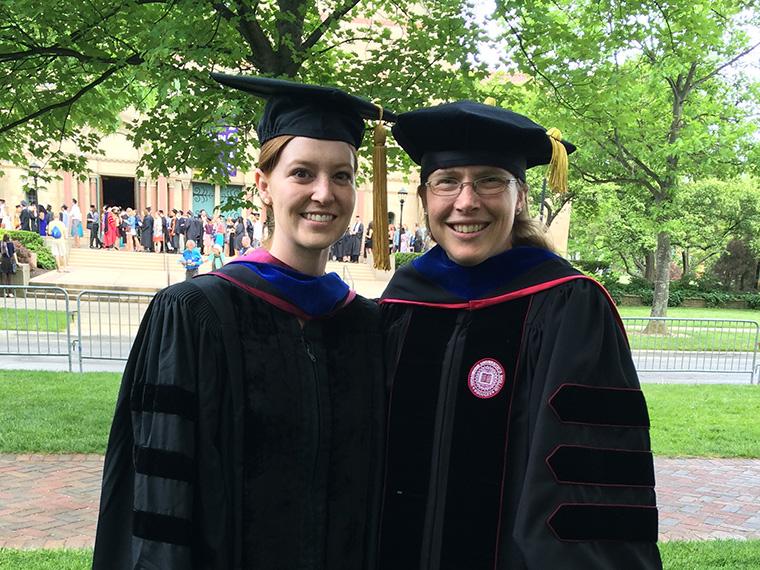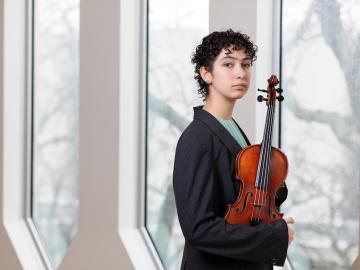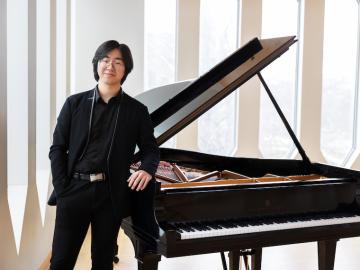An Interdisciplinary Approach to Teaching Biochemistry and Ethics
October 29, 2018
Hillary Hempstead

A biochemist and an ethicist walk into a classroom.
While this may sound like the beginning of a joke, at Oberlin, it actually happens. Recently highlighted in the Journal of Chemical Education, Assistant Professor of Chemistry and Biochemistry Lisa Ryno and Assistant Professor of Religion Cheryl Cottine conducted a team-taught, interdisciplinary module on the biological impact and ethical implications of pesticide use. Ryno employed the module with her advanced biochemistry students, and Cottine used it to teach her sophomore-level environmental ethics students. The course takes a collaborative approach to teaching, very much in line with a number of multidisciplinary courses taking place in StudiOC.
After becoming friends at their faculty orientation session, the idea of collaborating was top-of-mind for Ryno and Cottine. Then, the pair heard about a call for interdisciplinary projects that would be funded through Oberlin’s existing grant from the Howard Hughes Medical institute (HHMI). They formulated a plan for a team-taught module and were awarded a small sum to realize their project.
The module they created focuses on mechanisms and ethics of pesticide use domestically and agriculturally. Using Rachel Carson’s lauded Silent Spring as a primary text, they wanted to encourage students to consider the biological implications of pesticide use. To facilitate this, students would be asked to explore the chemistry of various pesticides and how they impacted biological systems and larger preservation and conservation practices. Each student would research a pesticide of their choice and then build a case for using or not using the pesticide—all while taking each potential stakeholder’s perspective into consideration.
In Ryno’s and Cottine’s course preparations, they wanted to ensure that they would be modeling an interdisciplinary approach to teaching for their students. They wanted to, from a pedagogical perspective, fully illustrate what this type of approach could look like. Not only that, they also wanted to support students in thinking critically about the biological and ethical implications of employing pesticides.
To assure an interdisciplinary teaching approach, the professors saw to it that all students had a baseline understanding of both ethical frameworks and pesticide mechanisms of action. They visited one another’s classroom to give students a crash course in relevant course material. Ryno lectured on pesticides to students in Cottine’s religion class, and Cottine informed biochemistry students about essential ethical frameworks.
Cottine says that by having students understand both basic biochemistry and how to apply ethical frameworks, students were able to examine the issues at hand in a more robust way.
“This unit gave them the tools to think about these problems from at least two very different fields. A solid answer to a tough question requires some background knowledge about how these things work. Understanding the chemical side of things, as well as understanding there are different justifications for approaching it from different ethical perspectives really enabled expansive critical thinking. Had I taught the unit myself, it really wouldn’t have been as effective,” says Cottine.
Ryno emphasises that, overall, the unit supported students’ development as well-rounded, critical thinkers. “This unit was a good exercise in students’ critical thinking—which is wholly the goal for every professor here. We want to have students learn to be successful critical thinkers, regardless of the topic,” says Ryno.
For many of the students involved, the pairing of subjects was illuminating. Neuroscience, biochemistry, and economics major Sohail Kamdar ’17 found the module to be different from any other science course he had taken before.
“This module [was] extremely engaging, as it was the first time any science class I took had a combination of two entirely different subject matters that enhanced my learning and understanding of both,” says Kamdar.
Ryno agrees that the module they used is distinctive, as ethics is not typically taught in this way in science courses: “Most of the time, when ethics is taught in the science classroom, it’s taught as research ethics. So [this module] was very different in that way.”
For Emma Brezel ’17, the course opened her eyes to new career possibilities and set her on the path for a graduate program in bioethics.
“At Oberlin, multidisciplinary learning is encouraged, but I never really considered how I could combine my interests in biochemistry and medicine with my interests in religion, anthropology, and law,” Brezel says. “I saw my interests in the humanities and social sciences as something that could inform my future choices as a health professional, but not something that could be front and center. This class motivated me to explore career options in bioethics. I was able to find a program with an emphasis on the clinical practice of bioethics, and I just completed a master’s degree in August. I'm doing research now, but I hope to attend medical school one day and work closely with a bioethics center.”
When asked about the module’s future, Cottine and Ryno are optimistic about teaching a full course together, possibly about biomedical ethics or the ethics of poisons.
Tags:
You may also like…
Students Create Project That Engages Local Hospital Patients and Nursing Home Residents
June 4, 2024
Oboist Meera Bhatia ’23 and flutist Emily Nixon ’23 visited local hospital and nursing homes over the past academic year, commissioning and premiering a piece by Jeff Scott through the Gletherow-Young-Deppman Project Award.
Violinist Maya Irizarry Lambright to Solo with Oberlin Orchestra
May 9, 2024
A winner of the 2023-24 Senior Concerto Competition, Lambright will open the program with Shulamit Ran's Violin Concerto. The second half of the program features the orchestra in Nikolai Rimsky-Korsakov's Scheherazade.
Pianist Jiongli Wang to Perform with Oberlin Chamber Orchestra
May 2, 2024
On Friday, May 3, the Oberlin Chamber Orchestra performs a program that will showcase Concerto Competition winner Jiongli Wang in Frédéric Chopin’s First Piano Concerto, as well as fourth-year composition student Cashel Day-Lewis in the premiere of his Black River Prelude commissioned by Oberlin Conservatory in honor of the Lorain County Bicentennial.


